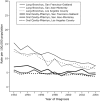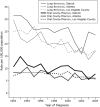Trends in incidence rates of tobacco-related cancer, selected areas, SEER Program, United States, 1992-2004
- PMID: 19080022
- PMCID: PMC2644579
Trends in incidence rates of tobacco-related cancer, selected areas, SEER Program, United States, 1992-2004
Abstract
Introduction: Recent trends in incidence rates for tobacco-related cancers may vary geographically because of variation in socioeconomic status and in history of comprehensive state tobacco control programs (starting with California in 1989). Recent trends in risk factors are likely to affect cancer incidence rates at the youngest ages
Methods: Trends in age-adjusted incidence rates for cancers most strongly associated with tobacco (ie, lung, oral cavity-pharynx, and bladder cancers) were analyzed for 1992 through 2004 in 11 areas (the states of Connecticut, Hawaii, Iowa, Utah, and New Mexico, and the metropolitan areas of Atlanta, Georgia; Detroit, Michigan; Los Angeles County, California; San Francisco-Oakland, California; San Jose-Monterey, California; and Seattle-Puget Sound, Washington) in the Surveillance, Epidemiology and End Results (SEER) Program. The 8 states differed in poverty rate of the population and in history of statewide tobacco control efforts as measured by an initial outcomes index (IOI) for the 1990s and a strength of tobacco control (SoTC) index for 1999 through 2000. Annual percentage change (APC) in incidence rate was calculated for whites and blacks separately and by sex for each SEER area.
Results: Among whites, the largest declines for lung cancer were in the 3 SEER areas of California, which were the only areas with significant (negative) APCs for oral cavity-pharynx cancer (but not for bladder cancer). For blacks, significant (negative) APCs for both lung and oral cavity-pharynx cancers were found in 4 of 5 areas with useful data but only 1 of 3 areas for bladder cancer. The strongest correlations of APCs for whites were for lung and oral cavity-pharynx cancers with the IOIs for the early 1990s and with the SoTC (due to the influence of California, which had the highest SoTC).
Conclusion: Lung and oral cavity-pharynx cancer incidence rates among whites aged 15 to 54 years declined more in California than in other areas, possibly because of comprehensive state tobacco control efforts. The different trends for bladder cancer vs other cancers could reflect the influence of risk factors other than tobacco. The greater geographic uniformity of trends among blacks than among whites for lung and oral cavity-pharynx cancers requires further study, particularly in relation to state tobacco control efforts.
Figures


Similar articles
-
The effects of race and ethnicity on thyroid cancer incidence.JAMA Otolaryngol Head Neck Surg. 2015 Apr;141(4):319-23. doi: 10.1001/jamaoto.2014.3740. JAMA Otolaryngol Head Neck Surg. 2015. PMID: 25654447
-
Geographic variation within the United States in the incidence of hepatocellular carcinoma.J Clin Epidemiol. 2003 May;56(5):487-93. doi: 10.1016/s0895-4356(02)00605-4. J Clin Epidemiol. 2003. PMID: 12812824
-
Lung cancer incidence trends in black and white young adults by gender (United States).Cancer Causes Control. 2004 Sep;15(7):665-70. doi: 10.1023/B:CACO.0000036176.33007.17. Cancer Causes Control. 2004. PMID: 15280624
-
Cancer incidence and mortality trends among whites in the United States, 1947-84.J Natl Cancer Inst. 1987 Oct;79(4):701-70. J Natl Cancer Inst. 1987. PMID: 3309421 Review.
-
Cancers of the oral cavity and pharynx in the United States: an epidemiologic overview.J Public Health Dent. 1996 Fall;56(6):309-18. doi: 10.1111/j.1752-7325.1996.tb02458.x. J Public Health Dent. 1996. PMID: 9089526 Review.
Cited by
-
Health inequality: a longitudinal study on geographic variations in lung cancer incidence and mortality in Taiwan.BMC Public Health. 2020 Jun 17;20(1):951. doi: 10.1186/s12889-020-09044-2. BMC Public Health. 2020. PMID: 32552808 Free PMC article.
-
Racial disparity in oral and pharyngeal cancer in Florida in 1991-2008: mixed trends in stage of diagnosis.Community Dent Oral Epidemiol. 2013 Apr;41(2):110-9. doi: 10.1111/j.1600-0528.2012.00738.x. Epub 2012 Aug 10. Community Dent Oral Epidemiol. 2013. PMID: 22882581 Free PMC article.
-
Analysis of primary risk factors for oral cancer from select US states with increasing rates.Tob Induc Dis. 2010 Feb 23;8(1):5. doi: 10.1186/1617-9625-8-5. Tob Induc Dis. 2010. PMID: 20178620 Free PMC article.
-
Overexpression of cyclooxygenase-2 in rat oral cancers and prevention of oral carcinogenesis in rats by selective and nonselective COX inhibitors.Cancer Prev Res (Phila). 2010 Jan;3(1):73-81. doi: 10.1158/1940-6207.CAPR-09-0151. Cancer Prev Res (Phila). 2010. PMID: 20051374 Free PMC article.
-
Genetic variations in epigenetic genes are predictors of recurrence in stage I or II non-small cell lung cancer patients.Clin Cancer Res. 2012 Jan 15;18(2):585-92. doi: 10.1158/1078-0432.CCR-11-2087. Clin Cancer Res. 2012. PMID: 22252258 Free PMC article.
References
-
- Kilfoy BA, Hudmon KS, Mande JR. Tobacco Control in State Comprehensive Cancer Control Plans: Opportunities for Decreasing Tobacco-Related Disease. Prev Chronic Dis. 2007;4(3):A61. http://www.cdc.gov/pcd/issues/2007/jul/06_0092.htm . - PMC - PubMed
-
- Gilpin E, Stillman F, Hartman A, Gibson J, Pierce J. Index for US state tobacco control initial outcomes. Am J Epidemiol. 2000;152:727–738. - PubMed
-
- Doll R. Progress against cancer: an epidemiologic assessment. Am J Epidemiol. 1991;134:675–688. - PubMed
-
- Jemal A, Cokkinides VE, Shafey O, Thun MJ. Lung cancer trends in young adults: an early indicator of progress in tobacco control (United States) Cancer Causes Control. 2003;14:579–585. - PubMed
Publication types
MeSH terms
Grants and funding
LinkOut - more resources
Full Text Sources
Medical
Miscellaneous

